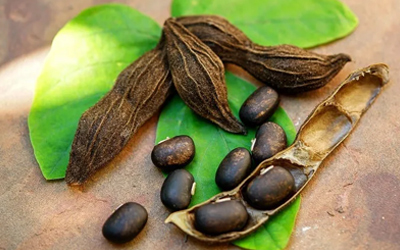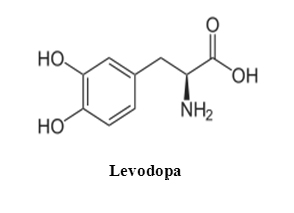
The plant is an annual, climbing shrub with long vines that can reach over 15 m in length. When the plant is young, it is almost completely covered with fuzzy hairs, but when older, it is almost completely free of hairs. The leaves are tripinnate, ovate, reverse ovate, rhombus-shaped or widely ovate. The sides of the leaves are often heavily grooved and the tips are pointy.In young M.pruriens plants, both sides of the leaves have hairs. The stems of the leaflets are two to three millimeters long. Additional adjacent leaves are present and are about 5 mm long.
The flower heads take the form of axially arrayed panicles. They are 15 to 32 cm long and have two or three, or many flowers. The accompanying leaves are about 12.5 mm long; the flower stand axes are from 2.5 to 5 mm. The bell is 7.5 to 9 mm long and silky. The sepals are longer or of the same length as the shuttles. The crown is purplish or white.
The flag is 1.5 mm long. The wings are 2.5 to 3.8 cm long. In the fruit ripening stage, a 4 to 13 cm-long, 1 to 2 cm-wide, unwinged, leguminous fruit develops. There is a ridge along the length of the fruit. The husk is very hairy and carries up to seven seeds. The seeds are flattened uniform ellipsoids, 1 to 1.9 cm long, 0.8 to 1.3 cm wide and 4 to 6.5 cm thick. The hilum, the base of the funiculus (connection between placenta and plant seeds) is a surrounded by a significant arillus (fleshy seed shell).
M.pruriens bears white, lavender, or purple flowers. Its seed pods are about 10 cm lonG and are covered in loose, orange hairs that cause a severe itch if they come in contact with skin. The chemical compounds responsible for the itch are a protein, mucunain and serotonin.[3] The seeds are shiny black or brown drift seeds.The dry weight of the seeds is 55 to 85 g/100 seed.

Mature seeds contain typically Levodopa, although up to 12.5% has been recorded. The leaves tend to contain around 0.5%.When looking at studies that take random marketed supplements off the market and analyze them, values tend to fluctuate in the lower range of
Tryptamine compounds (hallucinogenic compounds) are at rather low in the leaves and non-existent in the seeds; Dimethyltryptamine, 5-MeO-Dimethyltryptamine, and Dimethyltryptamine Oxide. 5-MeO-Dimethyltryptamine (Bufotenin) has been noted to be as high as 4.14ug/g in the root, but was not present in the pod.
In addition to levodopa, it contains minor amounts of serotonin (5-HT), 5-HTP, nicotine, N,N-DMT (DMT), bufotenine, and 5-MeO-DMT. As such, it could potentially have psychedelic effects, and it has purportedly been used in ayahuasca preparations.
The mature seeds of the plant contain about L-DOPA, with trace amounts of 5-hydroxytryptamine (serotonin), nicotine, DMT-n-oxide, bufotenine, 5-MeO-DMT-n-oxide, and beta-carboline. One study using 36 samples of the seeds found no tryptamines present in them.
The leaves contain about L-DOPA, dimethyltryptamine (DMT), 5-MeO-DMT and DMT n-oxide.
The ethanolic extract of leaves of Mucuna pruriens possesses anticataleptic and antiepileptic effect in albino rats. Dopamine and serotonin may have a role in such activity.
Collection of raw material in proper season from various regions of India. Authentication and Standardization of botanical species carried out respectively.
Our organization adopted USP based methods for extraction to maintain quality, safety & efficacy of our product by following GMP. For enrichment of herbal extract we optimized & monitored critical process parameters to achieve desire end product which conserve its natural aroma and taste to satisfy consumers need. Product is processed & stored under strictly hygienic production environment.
Phyto Life Science is always taking consideration of consumer’s requirement by providing them versatile products with below unique features:
Powder, Liquid and Oil soluble version also available
Store at cool and dry place
Important Note :-The information presented in this is for informational, reference and educational purposes only and should not be interpreted as a substitute for diagnosis and treatment by a health care professional. Although, the information presented about product is based on material provided by researchers and sources deemed reliable, we do not presume to give medical advice. The information presented here is the base on various Ayurveda & other book references and some market literatures and books and published papers. Anyone wishing to use this information should share it with his or her health care provider before embarking on any therapeutic program. It is your responsibility to discuss any alternative or natural remedy with your health care provider before use.